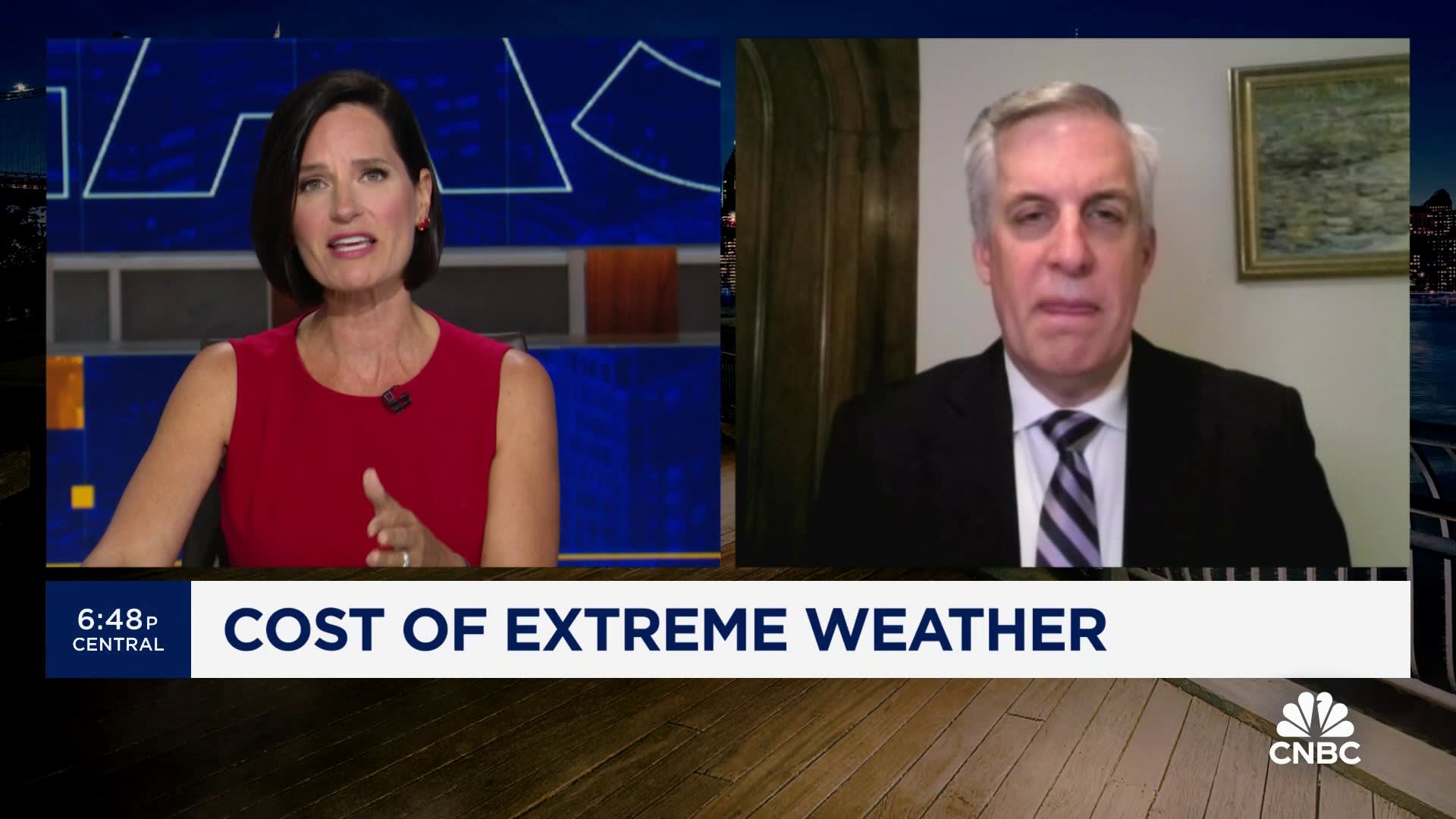Brandi Schmitt and her family pose for a 2018 Christmas card in front of their Maryland home wearing protective gear, alluding to the water and mold damage in their home. Each year, Schmitt said they try to capture the family’s situation through their Christmas card.
Courtesy: Brandi Schmitt
When a nor’easter struck in 2018, intense winds blew shingles, gutters and siding off Brandi Schmitt’s home in Lothian, Maryland.
Her family was without electricity for three days, during which time all of their food in the refrigerator spoiled and water continued to leak into the home, Schmitt said.
As soon as the power came back on, Schmitt said she called her insurance company, USAA, to report the damage.
An adjuster visited the home a week later, and determined the 5,000-square-foot roof needed a total replacement. While she and the insurer debated points of the claim, Schmitt said, the unrepaired damage allowed snow and water from subsequent storms that spring to seep through into her home.
What started as wind and water damage evolved into something much worse: mold.
Courtesy: Brandi Schmitt
An independent specialist found no mold in the home on May 2018, according to a “review for fungal activity” investigation documents USAA provided to Schmitt that CNBC reviewed. Then in October, a follow-up investigation found and “observed visible moisture and an increased moldy odor.”
In the intervening months, Schmitt and her family had developed health issues, including rashes and coughs. Their yellow Labrador and four guinea pigs all died within months of each other.
An immunoglobulins test result from November 2018 provided to CNBC by Schmitt shows high levels of antibodies in her blood from exposure to aspergillus niger, a common mold.
“I called [USAA] and said, ‘Are you going to wait for it to kill us?'” Schmitt said.
The family moved out of the house for good that same month.
Read more from Personal Finance:
Here’s where Kamala Harris could stand on tax policy, experts say
Is the U.S. in a recession? Roughly 3 in 5 Americans think so, report finds
Older voters face new decision in November with Harris poised to lead Democratic ticket
Despite paying for extra “fungus, wet or dry rot” coverage of up to $15,000 in her policy, Schmitt said USAA did not remove wet insulation from the attic where she believes the mold is growing. Air samples in the home taken in January 2020 found “problem mold concentrations,” according to fungal activity review documents USAA provided to Schmitt.
Schmitt and her husband, Joseph, sued the insurer in 2019. A unanimous jury on March 7, 2023, determined USAA materially breached the terms of their homeowner policy and awarded Schmitt $41,480 for interior repairs and $7,200 for additional living expenses. She is currently appealing the damages because of estimates that repairs will cost much more.
A spokesperson from USAA said the company is unable to address specifics due to that ongoing litigation, but said “USAA disagrees with the facts as characterized by Ms. Schmitt.” In a response to the suit filed in a Maryland court in March 2020, an attorney for USAA said the insurer did not breach its contractual obligations and the Schmitt family failed to mitigate damages.
Schmitt’s example may be extreme, but mold damage is not unusual. In 2022, water damage, including mold, represented 27.6% of homeowners insurance losses, according to data from Insurance Services Office, an industry group. And experts say these kinds of damages could become more prevalent as severe weather events, especially windstorms and flooding, become more common or more powerful.
Repairing mold damage is expensive and often left out or limited in homeowners policies, which can leave consumers without much help to cover a pricey problem.
‘We called it at the time a mold stampede’
Mold limitations and exclusions in policies became the industry norm after rulings in several high-profile lawsuits. One Texas case, Ballard v. Farmers Insurance Group, in 2001 initially resulted in a $32 million jury verdict, sending shock waves through the insurance industry. Despite the award for the owner of the mold-damaged home later being reduced to $4 million, companies still pulled back on mold coverage.
“We called it at the time a mold stampede,” said Amy Bach, executive director of United Policyholders, a San Francisco-based nonprofit that advocates on behalf of consumers. Schmitt shared her experience with the group as she sought help with her claim.
“One carrier after another said, ‘We’re capping it, we’re limiting it,'” Bach said.
We called it at the time a mold stampede. One carrier after another said, ‘We’re capping it, we’re limiting it.’
Amy Bach
Executive director of United Policyholders
Along with high-profile lawsuits, the high cost of repairs, uncertainty around health outcomes and memories of hefty asbestos payouts drove insurers to exclude and limit mold coverage, experts say.
“That unknown risk of the development of losses over long periods of time, that’s the risk that the consumer is transferring to the company, and that’s why it’s so regulated,” said KPMG U.S. insurance sector leader Scott Shapiro.
Will Melofchik, general counsel for the National Council of Insurance Legislators, said the organization’s members haven’t come across an increase in mold claims specifically.
“As long as customers can get the coverage they need somewhere in the market, carriers should have the ability to exclude things as long as the exclusion is clear and customers are aware of it,” Melofchik said.
How insurance does — and doesn’t — cover mold
Today, standard homeowners policies typically do not cover mold, fungus, wet or dry rot, unless that damage is the result of a covered peril, according to Insurance.com. (In policies, you’re likely to see it referenced as “fungus, or wet or dry rot” coverage. Mold is a type of fungus.)
Homeowners may need to add a rider to their policy to cover removal of mold stemming from other circumstances, like water backup or hidden water damage.
Many of those changes took hold swiftly after the 2001 Ballard verdict. A 2003 whitepaper from the Insurance Information Institute, an industry group, notes that “seeking to avoid becoming the next Texas, some 40 state insurance departments have now approved mold exclusions and/or limitations on homeowners insurance policies.”
Still, mold exclusions and limitations can come as a surprise to policyholders, according to Bach.
“Consumers reasonably expect coverage when there is property damage to their home,” she said. “And mold can clearly cause physical damage to the property that it comes in contact with.”
Unless the mold damage is a result of a sudden, covered peril — such as a bursting pipe or water heater flooding your basement — homeowners insurance typically won’t cover it, said Scott Holeman, media relations director for the III.
“In cases where mold has been around for a while, say several weeks or longer, it likely won’t be covered by your policy,” Holeman said. “Mold claims won’t be covered if it’s a result of neglect, such as pipe leaking for months resulting in water damage and mold.”

Peter Kochenburger, a visiting professor at the Southern University Law Center and professor at the University of Connecticut’s Insurance Law Center, says the policy language can be “convoluted.”
“You should always read your insurance policy and understand what you have, but no one’s going to do that,” Kochenburger said. “I do this for a living, look at insurance policies, and this is not easy.”
Insurance is regulated at the state level, which can cause additional confusion if some states have specific limitations and others don’t, he said. For example, in South Carolina, where hurricanes and flooding are common, there are no homeowner policies that cover all instances of mold, according to South Carolina Independent Agents. Instead, it’s determined by the peril.
Each company’s coverage is also different.
For example, USAA includes limited coverage — $2,500 for cleanup and $2,000 for additional living expenses — for mold resulting from a covered loss for no additional premium in most states, the company said in a statement. USAA also offers optional coverage beyond the standard policy in some states.
Nationwide covers up to $10,000 of mold damage caused by covered incidents, but that limit cannot be increased, according to a company spokesperson.
Mold claims can lead to nonrenewal of policies
Of a sample of anonymized home insurance-related complaints made about Allstate and Nationwide, 8% were mold related, according to data provided to CNBC by the Federal Trade Commission through the Freedom of Information Act. CNBC requested complaints about “home insurance” for a sampling of some of the largest property and casualty insurance companies, including Allstate, Nationwide and State Farm. State Farm had no mold-related complaints.
Most complaints focused on insurers limiting coverage on mold, but a few people mentioned seeing consequences when it came time to renew their policy. One policyholder in Lindsey, Ohio, said Allstate chose not to renew their policy in 2020 because they made a mold claim the year prior.
“Any limitations in terms of non-renewal do vary by state and are part of the regulatory framework,” Shapiro said. “Generally speaking, insurance companies do have the right to not renew you for any number of reasons, including prior loss history, which is often a trigger event.”

A Nationwide spokesperson said the company does not comment on individual claims. An Allstate spokesperson did not respond directly to a request for comment about the complaints, but directed CNBC to the III. Mark Friedlander, director of corporate communications at the III, said the volume and frequency of claims activity can be one of the reasons insurers choose not to renew a policy.
Insurance experts and attorneys recommend carefully reviewing the details of your insurance policy and consulting a professional to make sure you understand what’s included in the coverage.
Shapiro said insurers assessing future risk aren’t homing in on mold specifically yet, but it falls under the macro-issue of how climate will impact insurance, which the industry is tracking closely.
“There will be a limit to what insurance companies can do where society needs to come and assist with either affordability, incentivizing behavior, changing behavior, and that, in our view, doesn’t fall exclusively on an insurance company,” he said.
Six years after the nor’easter struck, the Schmitt home still sits uninhabited.
Schmitt and her family return to stay at the home occasionally so it’s not considered vacant or abandoned — and she said she still gets sick during those brief visits.
“During all this process, we never got to enjoy this house,” Schmitt said. “My husband and I have been together for many years and working really, really hard to be able to afford a home like this.”

